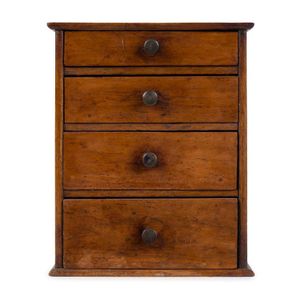Mahogany Apprentice Chest with Kauri Facias
You must be a subscriber, and be logged in to view price and dealer details.
Subscribe Now to view actual auction price for this item
When you subscribe, you have the option of setting the currency in which to display prices to $Au, $US, $NZ or Stg.
- Mahogany - Mahogany is a dense, close grained red-coloured timber from the West Indies and Central America. It was first imported into Europe in the the early 18th century and its use continued through the 19th century. It was popular for furniture making because of its strength, the wide boards available, the distinctive grain on some boards, termed flame mahogany and the rich warm colour of the timber when it was polished.. The "flame" was produced where a limb grew out from the trunk of the tree, and this timber was usually sliced into veneers for feature panels on doors, backs and cornices.
Some terms used to describe mahogany relate to the country from which it originally came, such as "Cuban" mahogany, "Honduras" mahogany etc. However unless the wood has been tested the names assigned are more a selling feature, rather than a true indication of the timber's origin.
This item has been included into following indexes:
Visually similar items

A late Georgian English oak chest of five drawers, 90 cm high, 98 cm wide, 51 cm deep. Provenance: Property of a Gentleman, Melbourne

A mahogany chest of drawers English, late 19th century, 107 cm high 110 cm wide 52 cm deep

George III oak flat front chest two short and three long graduated cock beaded drawers on bracket feet

A folk art miniature cabinet, eucalypt and cedar, South Australian origin, 19th century 40 cm high, 55 cm wide, 21 cm deep
